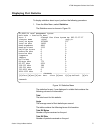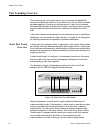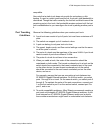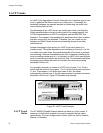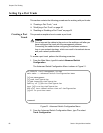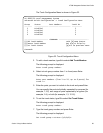AT-S84 Management Software User’s Guide
Section I: Using the Menus Interface 85
When a trunk is created, its default status is Disabled. This means that the
trunk does not pass network traffic or send/receive LACP data units
(LACPDU) until the trunk status is changed accordingly.
When a trunk is set to Active status, the trunk ports are all available as part
of the active LACP trunk. The trunk ports of an active trunk will all send
and receive LACPDUs. A minimum number of trunk ports determined by
the bandwidth requirements of the network traffic will pass network traffic.
Additional ports within an active trunk will dynamically be added or deleted
by the LACP feature depending on the increase or decrease of the
network traffic.
When a trunk is set to Passive status, the trunk ports are available to be
activated by their link partners. If the trunk receives LACP data unit
packets from an Active link partner, it automatically transitions to an Active
status. The trunk ports will not transmit LACP data units unless the link
partners are in the Active status.
A trunk set to Manual status is effectively a static trunk and has none of the
benefits of the LACP feature. The trunk ports of an active trunk will not
send or receive LACPDUs. The switch administrator must manually add or
delete trunk ports from a trunk.
LACP Port
Priority
Parameter
The switch uses this parameter to determine which ports are to be active
and which are to be in the standby mode in situations where the number of
ports in the aggregate trunk exceeds the highest allowed number of active
ports. This parameter can be adjusted on each port and is a number from
1 to 255. The lower the number, the higher the priority. Ports with the
highest priorities are designated as the active ports in an aggregate trunk.
For example, if both 802.3ad-compliant devices support up to four active
ports and there are a total of eight ports in the trunk, the four ports with the
lowest priority settings are designated as the active ports, and the others
are placed in standby mode. If an active link goes down on a active port,
the standby port with the highest priority is automatically activated to take
its place.
The default value of a port’s priority number is equal to 1.
The selection of the active links in an aggregate trunk is dynamic. It
changes as links are added, removed, lost or reestablished. For example,
if an active port loses its link and is replaced by another port in the standby
mode, the reestablishment of the link on the originally active port causes it
to return to the active state by virtue of its having a higher priority, while the
port that replaced it is returned to the standby mode.
In the unusual event that you set this parameter to the same value for
some or all of the ports of an aggregate trunk, the selection of active ports
is based on port numbering. The lower the port number, the higher the
priority.



